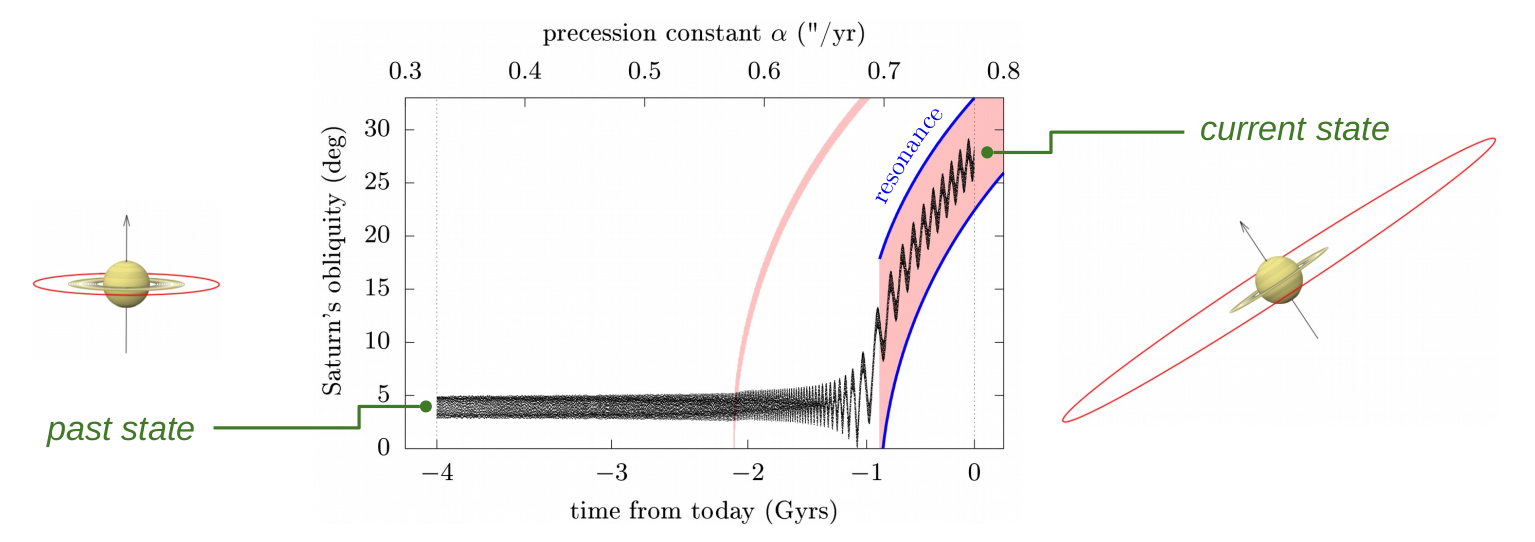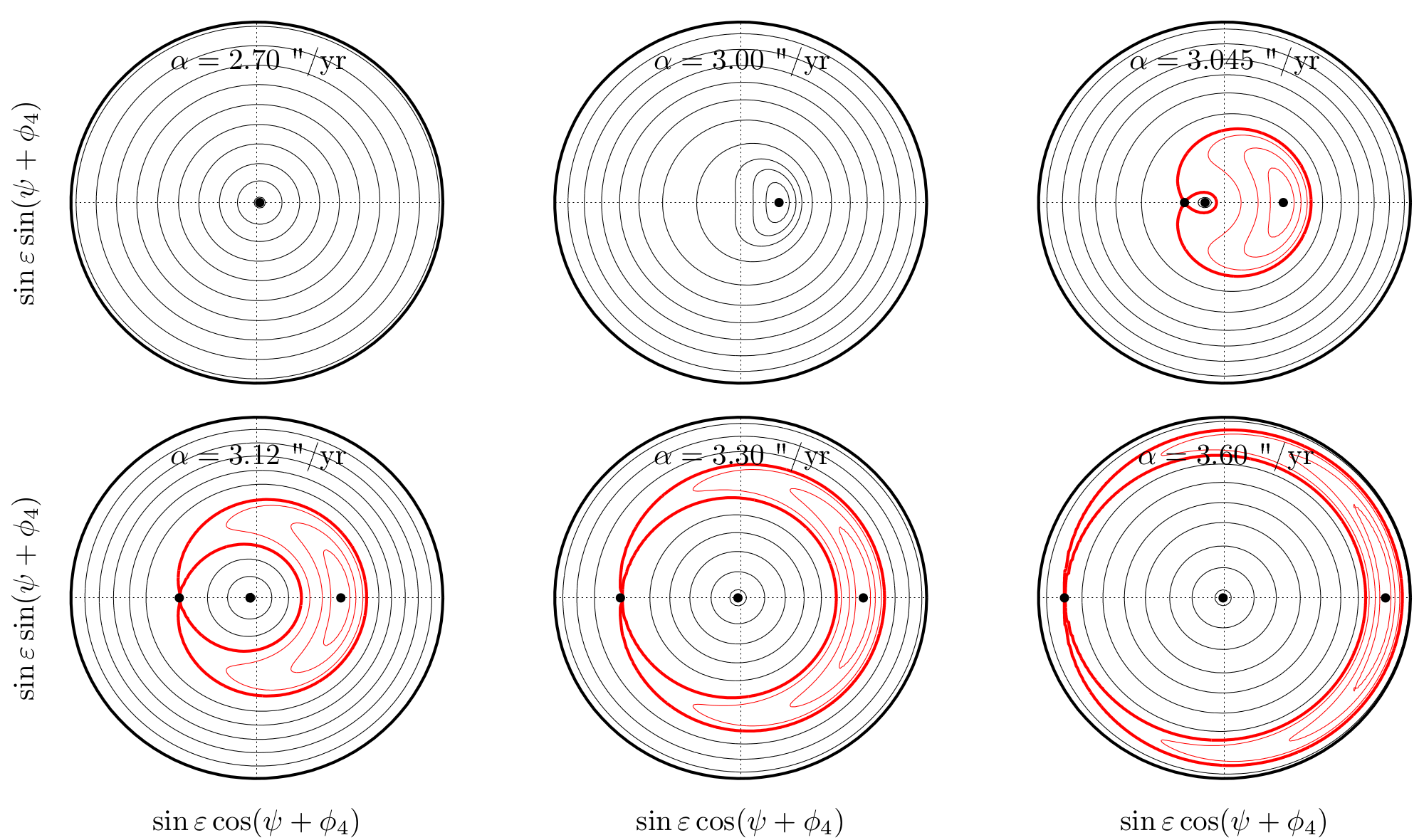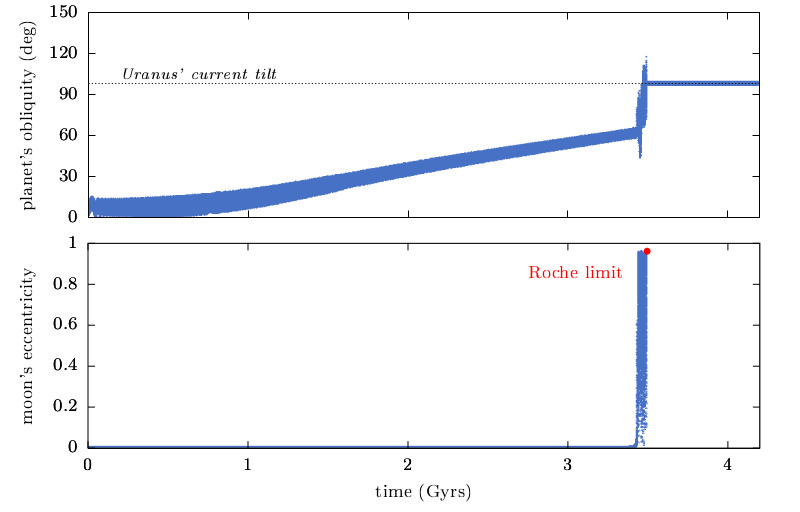
In addition to their orbital motion around the Sun, planets spins on themselves, and their spin axis itself describes a precession motion analogous to that of a spinning top. We call "obliquity" the angle between the equatorial plane and the orbital plane of a planet.
Because of the process of gas accretion taking place during their formation, giant gaseous planets initially have obliquities close to 0°. The current obliquity of Jupiter is indeed small (about 3°), but that of Saturn is not (about 27°).
As a result of their gravitational attraction, massive moons affect the motion of the spin axis of their host planet. Moreover, the moons of Jupiter and Saturn migrate over time (see the section about Natural satellites).
Together with Giacomo Lari and Gwenaël Boué, we have shown that the migration of Saturn's moons modify the precession frequency of its spin axis. As it was increasing, this frequency probably became equal to the precession frequency of Neptune's orbit, written s8. Through a resonance phenomenon, the equality between the two frequencies has then gradually tilted Saturn's spin axis down to its current orientation [xv].

These results imply that the tilting of Saturn is recent (it has started about one billion years ago), and continuous: as its moons migrate farther away, Saturn is more and more tilted. In the future billions of years, Saturn's obliquity may even exceed 65° [xvi]. Even though this scenario is the most probable one, it is not unique: the tilt of Saturn's spin axis may still be due to a very ancient event, as a giant impact.
An introduction to these results has been given by Gwenaël Boué in a wide audience conference at IAP (2021-11, in French). For more details, see the IMCCE newsletter #176 (in French) or the CNRS press release. These works have motivated "Research Highlights" in several journals including Nature and Astronomy & Astrophysics.
According to a subsequent study, it seems that Saturn is not trapped anymore in resonance today. If this is the case, then an additional mechanism must have desynchronised Saturn after the tilting of its spin axis, about 100 millions of years ago. The authors of this study suggest that Saturn could have had an additional moon that became unstable. They propose to relate this event to the controversial age of Saturn's rings. These theories are currently much debated in the scientific community [xxiii]. On this subject, listen to Alexandra Delbot's broadcast in France culture (in French).
The spin axis of Jupiter is also expected to be gradually tilted in the future, because of the tidal migration of the Galilean satellites (see the section about Natural satellites). The obliquity increase of Jupiter involves a resonance with the precession frequency of Uranus's orbit, written s7. The future obliquity of Jupiter may then exceed 30° in the future five billions of years from now [xiv].

These results have strong consequences. Contrary to what astronomers used to think, the obliquities of Jupiter and Saturn have not been constant for more than four billions of years. Instead, they continuously evolve: what we observe today is just a transitory stage of their evolution.
This tilting process is generic. It has probably operated as well on a large fraction of exoplanets. On a timescale of several billions of years, the system converges towards a configuration where the migrating moon becomes unstable (see the section Natural satellites). This instability puts an end to the tilting process, eventually freezing the planet's obliquity to values near 90° [xvii]. Hence, the distribution of obliquities among giant gaseous exoplanets is probably very broad, in sharp contrast to the 0° obliquities that one would expect from planetary formation processes.
Because of its 98° obliquity, Uranus seems to be exceptional among the Solar System giant planets.

It is generally accepted that Uranus has evolved through a phase a giant impacts, which gave a random orientation to its spin axis. However, this hypothesis contradicts the great similarity observed between Uranus and Neptune (mass, radius, spin rate, etc.). Besides, the spin rate of Uranus is consistent with formation models without collisions. If Uranus and/or Neptune had been struck by giant impacts, then the probability to obtain two planets that are so similar is virtually zero. Therefore, we must look for alternative scenarios.
In collaboration with Zeeve Rogoszinski, Giacomo Lari, and researchers from IMCCE and OCA, we have shown that an ancient hypothetical moon around Uranus could have inclined its spin axis through a mechanism similar to that observed for Jupiter and Saturn. By converging towards an unstable configuration, the previous moon would then have naturally been disrupted during the final stage of this mechanism.

If this ancient moon was massive enough (of the order of Ganymede's mass – the moon of Jupiter), then the probability to obtain the current state of Uranus can exceed 80 % [xix].
The orientation of a planet's spin axis is directly related to seasonal changes and climate stability. In collaboration with Jacques Laskar and Gwenaël Boué, we have developed an analytical formulation for the long-term dynamics of planetary spin axes. This formulation allows one to locate resonances and chaotic zones, even if the parameters of the planetary system are not well known [x]. Exoplanets for which the spin axis is necessarily stable are priority targets for new observations, because they may be more prone to the emergence of life.
However, the orientation of the spin axis of an exoplanet is extremely hard to measure – unless this exoplanet possesses a ring (because a ring, as that of Saturn, remains perpendicular to the planet's spin axis). And indeed, the presence of rings has been proposed for some exoplanets qualified as "super-puff", for which the radius appears to be anomalously large.

Such a large increase in the apparent radius of an exoplanet would require that this exoplanet has a obliquity close to 90°, which seems to contradict the formation mechanism of giant gaseous planets (see top of this page).
As part of a collaboration with Sophia Sulis, Paul Charpentier and Alexandre Santerne, we have shown that the spin axis tilt of the exoplanet HIP 41378 f and the formation of a ring can naturally be explained if this planet once had a moon [xxi]. This previous moon would have had properties that are fully consistent with what we expect for moons around giant planets.

These results are particularly useful in the context of ESA's PLATO mission, that will be launched in 2026. Indeed, the observation strategy of PLATO will favour the characterisation of long-period exoplanets, which are more prone to harbouring rings and moons [xxvii].
As part of a collaboration with Yubo Su, we have shown that close-in planets, which undergo energy dissipation due to stellar tides, can also be efficiently tilted via this mechanism [xxix]. Hence, moons (even those that have been lost) play a critical role in the final obliquities of warm exoplanets, which poses a serious challenge in predicting the present-day obliquities of observed exoplanets.
Last update: 2025-11.